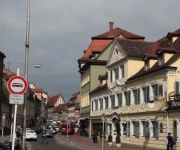Facts and Data
Webpages:
Official Unesco Page
City of Bamberg - Documentation Centre World Heritage
Tourism & Congress Service
UNESCO Commission of Germany
Altstadt von Bamberg (Deutsche UNESCO-Kommission)(only german)
Town of Bamberg (Town Council of Bamberg)(german only)
Basis Data:
Unesco World heritage since: 1993
Size of heritage: 142 ha
- Buffer zone: 444 ha
Coordinates:
Longitude: 10,889°
Latitude: 49,892°
Summary
From the 10th century onwards, this town became an important link with the Slav peoples, especially those of Poland and Pomerania. During its period of greatest prosperity, from the 12th century onwards, the architecture of Bamberg strongly influenced northern Germany and Hungary. In the late 18th century it was the centre of the Enlightenment in southern Germany, with eminent philosophers and writers such as Hegel and Hoffmann living there.
Location on Map
Show bigger map on Openstreetmap
Introduction
The Town of Bamberg is a UNESCO World Heritage site located in the District of Upper Franconia in Germany. It is renowned for its well-preserved medieval and baroque architecture, which reflects the town's rich history and cultural significance. This article will delve into the history of the heritage site and provide an overview of its current state.
History
The history of Bamberg dates back to the 10th century when it was founded as a bishopric by Emperor Henry II. The town quickly flourished under the rule of the bishops, who transformed it into a center of religious and political power. The bishops' influence is evident in the numerous ecclesiastical buildings that dominate the town's skyline.
During the 17th century, Bamberg experienced a period of prosperity and cultural growth. The town became a hub for arts and sciences, attracting renowned scholars and artists. This period of prosperity is reflected in the baroque architecture that characterizes much of the town.
Current State
Today, the Town of Bamberg stands as a testament to its rich history and architectural heritage. The well-preserved medieval and baroque buildings have earned it the recognition as a UNESCO World Heritage site in 1993.
One of the most iconic landmarks in Bamberg is the Bamberg Cathedral, also known as the Imperial Cathedral of St. Peter and St. George. This magnificent structure combines elements of Romanesque and Gothic architecture and houses the tombs of Emperor Henry II and Pope Clement II.
Another notable site is the Altes Rathaus, or Old Town Hall, which is situated on an island in the middle of the Regnitz River. This half-timbered building is a unique architectural gem and is one of the most photographed buildings in Germany.
The town's medieval layout, with its narrow winding streets and picturesque squares, adds to its charm. Visitors can explore the enchanting Old Town, which is home to numerous historic buildings, including the Alte Hofhaltung, a former residence of the bishops, and the Klein-Venedig, a row of colorful fishermen's houses along the river.
Bamberg is also famous for its beer culture. The town is home to nine breweries, each producing its own unique beer. The traditional brewing methods and the variety of beer styles make Bamberg a paradise for beer enthusiasts.
Conclusion
The Town of Bamberg in Germany's District of Upper Franconia is a UNESCO World Heritage site that showcases the town's rich history and architectural heritage. From its medieval and baroque buildings to its picturesque streets and squares, Bamberg offers visitors a glimpse into the past. The town's cultural significance, combined with its beer culture, makes it a must-visit destination for history enthusiasts and beer lovers alike.
Hotels and places to stay
Bamberger Hof Bellevue
Villa Geyerswörth
Messerschmitt Weinhaus
Graupner Garni
Wilde Rose Gasthof
Brudermühle
Casa-Italia
Central
Alt Bamberg
ibis Bamberg Altstadt
Videos from the area
Videos provided by Youtube are under the copyright of their owners.



















